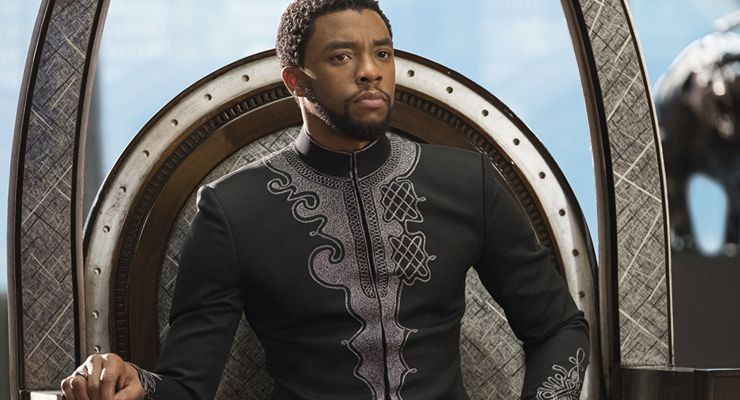
“Men, you’re the first Negro tankers to ever fight in the American Army. I would never have asked for you if you weren’t good. I have nothing but the best in my Army. I don’t care what color you are as long as you go up there and kill those Kraut sonsofbitches.”
– General George S. Patton addressing the 761st Tank Battalion
As one of only nine “playwrights” in the U.S. Army’s Signal Corps, it’s possible that Stan Lee heard about the all African-American 761st Tank Battalion, the original ‘Black Panthers’ from WWII. They were African-American soldiers fighting for America who were banned from serving with white troops by federal law. A biopic for Jack Kirby, Lee’s co-creator of the Black Panther comic, might include a frontline encounter between Company F Infantry Scout Kirby and the Black Panther Battalion. Tasked with drawing reconnaissance maps and landmarks, Kirby might have drawn them like some lost scene from David Ayer’s film FURY (2014). In the Marvel Universe, there are so many possibilities. In a parallel timeline, perhaps Oakland’s Merritt College Bookstore carried The Fantastic Four, issues #52 or #53 (July-August 1966) where Huey P. Newton and Bobby Seale might have seen it on their way to an Afro-American Association meeting. Their Black Panther Party began patrolling Oakland in October of that same year.
Back in the sixties, Marvel may have tapped the zeitgeist of the times, just like they’ve done now with the 18th installment of the Marvel Cinematic Universe (MCU), BLACK PANTHER, but it’s more likely coincidence. After all, Stokely Carmichael’s Student Nonviolent Coordinating Committee was already using the image of a Black Panther in association with the Lowndes County Freedom Organization prior to Marvel’s introduction of Black Panther. Acting as real-life superheroes, its members registered over 2,500 African-American voters between 1965 and 1969 in the most Klu Klux Klan-dominated area of Alabama.
Kirby was progressive in his views and certainly willing to punch a Nazi himself. But Lee, as a matter of fact, was often disturbed by the political activities on campuses in Oakland and neighboring activist communities like Berkeley throughout the late 60’s. His writing on such topics often ranged from “Get-a-job-Hippy” screeds to entreaties on “Why can’t we all get along?” By 1972, Lee attempted to downplay the association renaming Black Panther as ‘Black Leopard’ in issue #119 of The Fantastic Four (February 1972). Therein, he had the character formally known as Black Panther state “I contemplate a return to your country, Ben Grimm, where the latter term has — political connotations. I neither condemn nor condone those who have taken up the name, but T’Challa is a law unto himself. Hence, the new name—a minor point, at best, since the panther is a leopard.” T’Challa is the Black Panther and the King of Wakanda, a mysterious African nation that has undreamed of technology at their disposal.
Lee’s name change did not stick. Come July of 1973, the Black Panther was published as the lead character in the comic series Jungle Action (issue #5). Those preceding four issues of Jungle Action contained reprints of 50’s era Tarzan rip-offs like Lo-Zar, Lord of the Jungle. A fortuitous redemption of the series broke new ground in the hands of writer Don McGregor.
Though it’s a common practice now, McGregor pioneered the multi-part storyline for comics, writing two extended tales over the course of 24 issues. It was in that first storyline “Panther’s Rage” where much of the movie’s characters and concepts were first introduced. Unfortunately that second story-line “Panther vs. the Klan” proved too revolutionary. In 1976, Jungle Action was cancelled and its storyline was never completed. Apparently going up against the Klan was deemed too controversial at the time… or perhaps some editor thought they included some very fine people.
This would not stop the Black Panther. His self-titled series would see publication in January the next year. Returning to artist Jack Kirby who also took over writing for the initial twelve issues, this first volume of the Black Panther comic ran until 1979. Over the next thirty-nine years, Black Panther would be featured in a variety of Marvel comics, as titular character, a guest star, or a team member. Today, his adventures are chronicled by the able Ta-Nehisi Coates.
Despite this current sensitivity, Marvel has a far from perfect record when it comes to reflecting the culture at large. While Marvel Studios appears prescient in their timing of BLACK PANTHER’s release, much of it could be the exploitation of coincidence. Studio President Kevin Feige expressed regret for not being the first to deliver a female-lead superhero, ceding that victory to DC’s WONDER WOMAN (2017). And while BLACK PANTHER lacks a female lead too, the supporting cast of Wakandan women are all very strong and empowered, almost like bevy of MCU Black Widows.
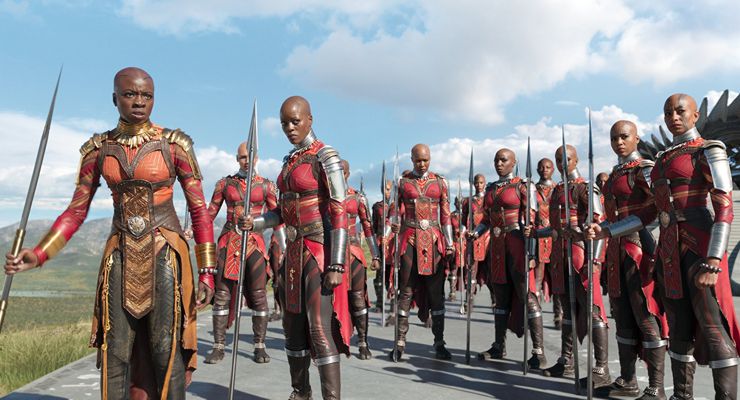
At Marvel Comics, those cultural missteps can have greater ramifications. It is common practice for comic publishers today to publish some sort of epic summer event. Usually this takes the form of a limited series which includes almost all of the publisher’s comic properties in a storyline which crosses-over into most, if not all, of their popular titles. In 2017, Marvel’s big event was a storyline titled “Secret Empire” which in essence claimed that Captain America has secretly been a Nazi all along. The event was a disaster, both critically and financially, resulting in the sudden replacement of Editor-in-chief Axel Alonso with C.B. Cebulski, who initially joined Marvel in virtual yellow-face, posing and giving interviews under the guise of a Japanese Manga creator Akira Yoshida – not a good look.
In light of this, Marvel Studios continues the work of redeeming the publishing house from which it spawned. Seeming to have learned from the accusations of white-washing which accompanied the release of DOCTOR STRANGE (2016), Marvel Studios made a concerted effort to insure that BLACK PANTHER (2018) would effectively demonstrate the appeal of an Afrocentric imagery and remain broadly Iconic. Black Panther, like IRON MAN (2008), could have anyone in its suit, It just happens to be worn by the King of the world’s most advanced civilization. In a movie filled with a large cast, it’s worth noting that only three of them are played by white actors. Two are from Peter Jackson’s Hobbit franchise: Martin Freeman, reprising his MCU CIA role as Everett K. Ross and Andy Serkis as the villainous Ulysses Klaue, a role he seems psychotically giddy to play because it exposes his real face, not another CGI mask under which he’s been typecast. The third is the omnipresent Stan Lee, a minor cameo but essential to any MCU installment.
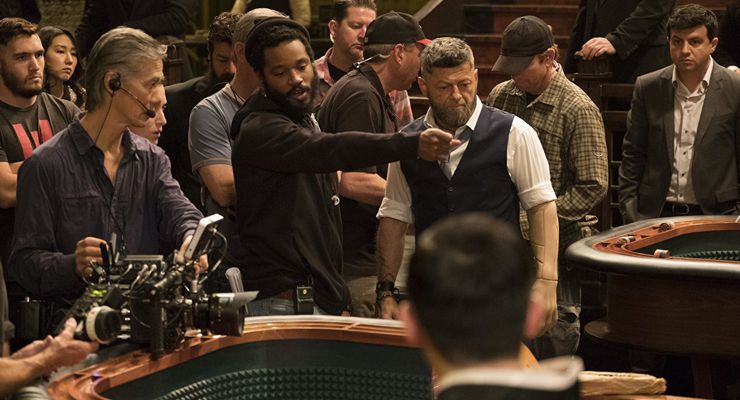
Wakanda Forever
The new MCU BLACK PANTHER was officially announced in October 2014, over a year after the Black Lives Matter movement began, but like with the Black Panther Party, there’s no way Marvel could have foreseen the state of America when it was scheduled to premiere. BLACK PANTHER takes on racial prejudice, as well as issues of gender, technology and immigration with unusual panache for a comic book film by taking the high road and not letting the story get too bogged down with politics (although racist vitriol has already appeared in reaction – a sad symptom of our times). It’s a refreshing spin on the MCU formula, replete with that light witty humor while saving the world from imminent destruction that Marvel has capitalized upon with such aplomb.
Though Wakanda may be the primary location for this movie, it retains an international feel regardless visiting the U.S., the E.U. and South Korea over its 2 hour 14 minute run time. As a result BLACK PANTHER ends up feeling more like the international spy thriller CAPTAIN AMERICA: CIVIL WAR (2016) aspired to be rather than a Sci-Fantasy comedy like THOR: RAGNOROCK (2017). Could this be another benefit of not having a blonde-haired, blue-eyed Chris in the lead role?
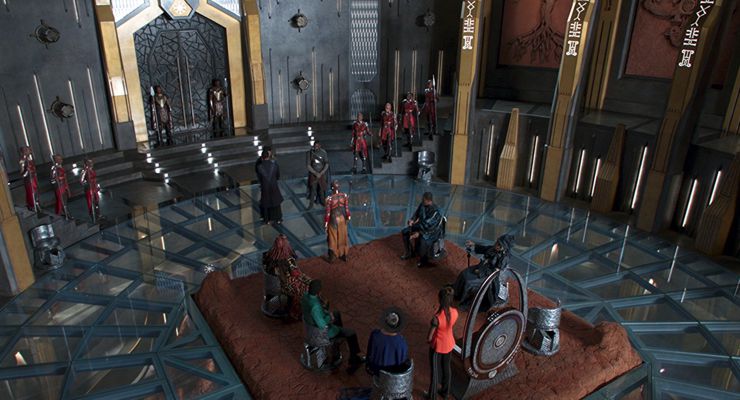
The movie is gorgeous to behold. Long gone is the blue and gray palette of Marvel’s early films. Not nearly as garish as recent offering like GUARDIANS OF THE GALAXY (vol.1 2014 & vol 2 2017) or ANT-MAN (2015), it remains colorfully vibrant and beautifully designed, benefitting heavily from that African aesthetic. Production designer Hannah Beachler traveled extensively throughout Africa in preparation for this film, all that work and research is clearly on display. This is a movie well worth splurging on in 3D.
What’s more, it’s a brilliant listen. Kendrick Lamar, a.k.a. Kung Fu Kenny may well deliver Marvel’s first chart topping hit with his pop collaboration with SZA, the title song “All the Stars”. Lamar taps many other hot talents for the soundtrack including Ab-Soul, Future, Schoolboy Q, Travis Scott, Jorja Smith, Anderson.Paak, and the Weeknd. In addition, composer Ludwig Göransson spent a month with in Senegal researching traditional music with the world renowned musician Baaba Maal. Immersive 3D has been a hallmark of recent MCU installments, but this musical cast takes BLACK PANTHER to a whole new level. The film is a feast for the senses, and delivers its message with a lot of heart.
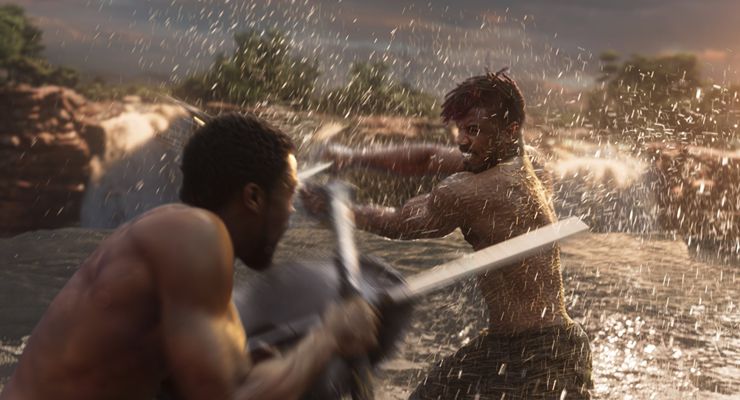
Warriors of Wakanda
Beyond the common film criticism, KungFuMagazine.com always looks at the fight choreography. Clayton J. Barber, a former National Taekwondo champion serves as Fight Coordinator for BLACK PANTHER. Barber has been in the stunt industry since 1993, starting as a stuntman for Mighty Morphin Power Rangers. The first major fight – the casino battle – contains a striking single-shot sequence, a real centerpiece of action choreography. It’s digitally-stitched, almost seamlessly transitioning from live action to CGI, so it’s not a true single-shot, but it is sophisticated and complex, and quite a testament to Barber’s skill in delivering a fight scene.
Although Wakanda is a make-believe land, BLACK PANTHER strives for some authenticity in the African warrior culture just as it does with the design and music. In the film, Wakanda warriors bear traditionally-inspired African weapons like the Assegai (spear), the Rungu (a knobby club), the Membele (a multi-bladed throwing knife), the Shotel (a sickle-like sword) and Nguni shields. However, the legacy of African martial arts is murky. Da’Mon Stith is one of the leading authorities on African martial arts in America, as well as a star of Man at Arms: Art of War. Stith explains. “The history of Africa is shrouded in mystery, earning the eponym the ‘Dark Continent’, conjuring the images of half-naked savages dancing to drums waiting for civilization to come in the form of colonialism. This image has shaped the minds of academics and laymen alike throughout the centuries, forcing the continent to remain in a perpetual state of need and backwardness. Many are surprised when they hear about the various empires, kingdoms, and states that existed throughout the continent. Though we know very little about these states, they should serve as an indicator that more emphasis should be placed on understanding and uncovering Africa’s past. There are myriad of complications in this regard but in recent years scholars are starting to rewrite the history of Africa and to shatter the many myths that ravage the continent from north to south.
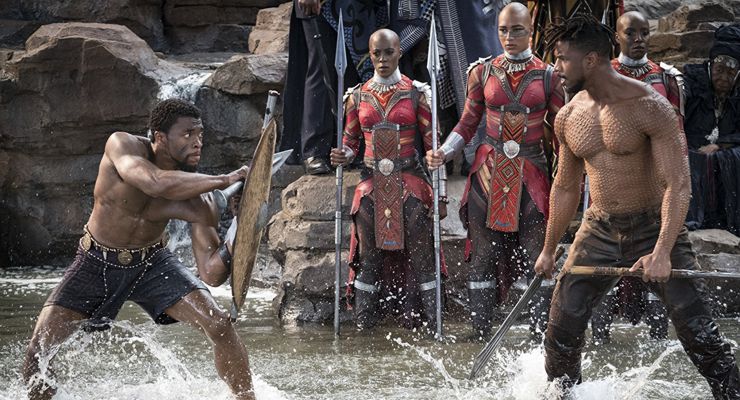
“It has long been established that Africa is the cradle of humanity. It seems that Africa may in fact be the cradle of martial culture too, or at least contains the earliest documented references to organized systems of training and fighting. Although I am not a proponent of the idea that all martial arts descended from one starting point and spread throughout the world, I know that the earliest references to martial arts and combat sports can be found in Africa. In ancient Egypt (part of the African continent) there are hundreds images depicting a sophisticated system of wrestling, stick fighting, boxing, and archery on the walls of the tomb of Beni Hassan and many other frescos and monuments. These combat modalities can be found throughout the continent but in intriguingly high frequencies in East Africa, especially amongst the Moro Nuba who still practice wrestling, wrist-knife boxing, and two forms of stick-fighting found also in Pharaonic Egypt. That is not to say that these arts are descendants of those ancient forms but it does illustrate the connection between Egypt and the rest of Africa especially its neighbors to the south.”
The bulk of the combat in BLACK PANTHER is with weapons. Spears, shields and swords, all powered by the Wakanda’s magical meteorite metal vibranium, are the cold arms of choice. The vibranium makes the weapons glow blue and pwerful enough to penetrate tanks, but really all fantasy film weapons are in the wake of light sabers. The elite royal guard of Wakanda are called the Dora Milaje, Amazon-like women with bald heads that one character calls “Grace Jones-looking chicks”. They wield collapsible spears that, like a light saber, expand to a full-sized weapon with a flick of a switch. Leading the Dora Milaje is General Okoye, played by Danai Gurira, best known as the katana-wielding heroine Michonne from The Walking Dead. Gurira has the background in stage combat and kickboxing and trained extensively with sword for Michonne. She steals every scene she’s in with her spearplay.
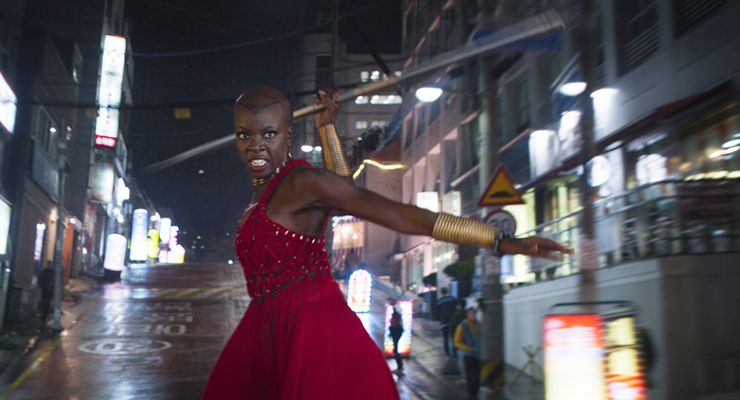
“’The stick is grandfather of the sword’” says Stith, quoting Cheikh Belmekki. “Cheikh Belmekki of Algeria is a practitioner of al Matrag, a form of stick fencing practiced in western Algeria that may descend from medieval Mamluk training methods for the sword. His sentiment is not only echoed amongst other practitioners of al Matrag but can be seen as a truth amongst other stick fencing systems where the stick is safe substitute for more lethal weapons such as the sword, war club, axe, and spear. In ancient Egypt, there are at least four modalities of stick fighting that was practiced: Long Stick, as depicted in the sport of water jousting which include thrusting techniques, swings, levered throws and stick grappling, Single Stick, Double Stick, and Stick and Shield. Many of those forms are still practiced by different people in East Africa. Long Stick and Stick and Shield are still practiced by the Nuba in Sudan. Arts such as Tahtib (Egypt) and Donga (Ethiopia) retain the practice of Long and Single Stick, bearing witness to the continual importance of stick fighting as a means of self-defense and cultural expression. Others known for stick fighting are the Nguni people of South Africa including the Zulu and Xhosa, the Maasai with their Runga (war clubs) and double stick fighting, the Hausa of northern Nigeria, the Suri of Ethiopia (Donga), al Matrag (Algeria), Tahtib (Egypt), the Swahili stick dance of Lamu island to name a few. This practice of stick fencing even extended into the African diaspora where various forms exist on the islands of Haiti (Haiten Baton), Trinidad and Tobago (Kalenda), Grenada and Barbados (Stick licking) and in Brazil, there is Jogo do Pau and Maculele.”
Oaklandish
KungFuMagazine.com headquarters is in the ‘five and dime’ – the east bay region of San Francisco where the area code is 510. Oakland is about 30 miles north, so it was delightful to see Oakland showcased in BLACK PANTHER. Director Ryan Coogler’s breakout feature film was FRUITVALE STATION (2013) which dramatized the horrific police shooting of Oscar Grant III in Oakland. Grant was played by Michael B. Jordan, who also stars in BLACK PANTHER as Erik Killmonger. With the aforementioned Oakland connection to the Black Panther Party, BLACK PANTHER has a local connection for KungFuMagazine.com that is proudly represented. It’s not Wakanda. It’s our ‘hood. East Bay Massive!
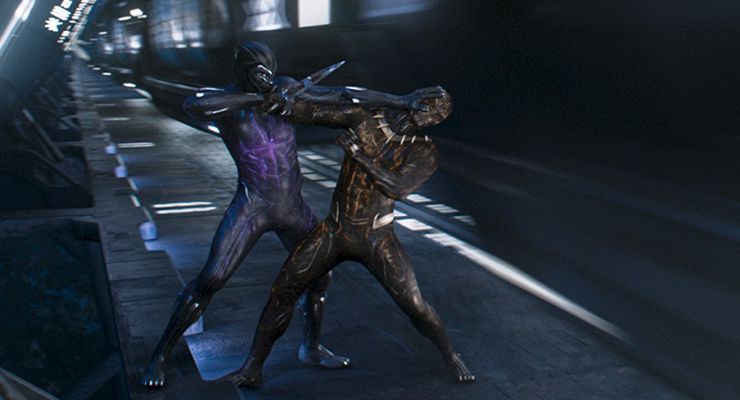
Written by Gene Ching for KUNGFUMAGAZINE.COM
COPYRIGHT KUNGFUMAGAZINE.COM, ALL RIGHTS RESERVED.
All other uses contact us at gene@kungfumagazine.com





